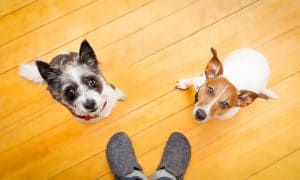“This post contains affiliate links, and I will be compensated if you make a purchase after clicking on my links.”

Dear Steve,
Grady is a 5-yr-old Weimaraner and he chews up everything he can get his paws on. Lately, he’s been chewing and scratching the closed door leading to the bedroom. Yesterday, he chewed half the door. He had a doggie door, three energetic siblings, a fenced 1.5 acre yard, and plenty of chew toys and stuffed animals. He never used to do this but has been getting progressively worse. Yesterday was pretty awful. Can you help? I’m at work for 9 hours a day, home on weekends. I play with him and his sibs every day, too.
Thanks,
Sue
Hi Sue, thank you for your question. The issue of destroying items in the home is a common challenge for many dog owners. This is a struggle that plagues both puppy and adult dog owners of all breeds and sizes. You make several statements in your question that I find to be very telling and immediately stood out as potential contributing factors. We will deconstruct each of these statements in a minute, but I first want to say that destruction in the home is often times a symptom, not the problem. It’s critical to understand this, as we need to determine and address the underlying cause, not simply attack the more obvious symptom.
The two most common causes of destruction in the home are: excess pent up energy and separation anxiety. Excess pent up energy is more common, but separation anxiety is much more difficult to resolve. It’s important to know what your dealing with, in order to come up with the proper training plan. One distinguishing attribute of separation anxiety is the dog displaying physiological changes such as increased heart rate, drooling, and higher breathing (panting), etc. Separation anxiety is often times triggered by a major change in routine, lifestyle or living situation. Have you recently moved to a new home? Are you on a new work schedule (i.e. longer hours, working nights instead of days, etc.)? Did a family member move out or pass away?
If an event like this has preceded the onset of this destruction, then you may be dealing with separation anxiety. To learn how to improve separation anxiety, read my article and watch my video here.
Now onto a more in-depth analysis of your question:
I am not one who likes to generalize and base my training on a dog’s breed, as each dog is unique and there is a large gradient of difference among dogs within the same breed. However, the first thing you mention is your dog is a Weimaraner. They are typically a very active breed that requires significant exercise and mental stimulation multiple times per day. It’s important to be cognizant of each dog’s individual attributes and plan your training accordingly.
The next thing you mention is, “He had a doggie door, three energetic siblings, a fenced 1.5 acre yard, and plenty of chew toys and stuffed animals.” This is a very common statement I hear from clients all the time. We would think these items are suitable outlets for exercise and mental stimulation, but they are not enough. These are nice options for a dog to have, but they do NOT replace the fundamentals. What do I consider to be the fundamentals? A structured walks, structured play sessions, and obedience training. I will discuss these more later on.
The last part of your question that I find to be significant is, “I’m at work for 9 hours a day, home on weekends. I play with him and his sibs every day, too.” I think it is fantastic you play with the dogs every day, but 9 hours is a very long work day for these dogs to be left alone. I suggestion my clients who are out of the home for 6+ hours at a time, to have someone come in mid-day to take their dog for a structured walk and/or structured play session.
What are the takeaways for Sue and other struggling owners…
Dogs have two forms of energy (just like us), mental and physical energy. We must provide appropriate outlets for this energy, otherwise it will build. Pent up energy will cause the dog to look for an outlet that we view as unacceptable (i.e. destroying items in the home). I consider a structured walk and structured play session to be the best for physical energy and obedience training for mental energy.
What do I mean by a structured walk? A structured walk is with the dog walking comfortably at your side on loose leash. The dog should NOT be constantly sniffing, marking, and pulling. There is a time and place for the dog to sniff and go to the bathroom on the structured walk, but the majority should be loose leash walking at your side. This provides physical exercise, but also mentally stimulation. The dog uses impulse/self-control by not reacting to everything they walk by, which is mentally fatiguing. The length of the walk varies depending on the dog’s age, size, overall health, and owner’s capabilities. So find what is best for you and your dog.
Structured play sessions should be done in conjunction with, not as a replacement for, a structured walk. To learn more, check out my previous article and video contribution on How to Play a Structured Game of Tug with Your Dog.
The last element is obedience training. Not only will this help make your dog more obedient in life, but it’s a terrific way to drain your dog’s mental energy. Other activities like nose or scent work are great, but not as practical for the family dog owner. You would be very surprised at how mentally fatiguing just 5-10 minutes of concentrated obedience training can be for a dog. You will notice your dog doing great with commands at the beginning of a session, and toward the end they start messing up on something they were doing great just 5 or 10 minutes before. That is a telltale sign your dog is getting mentally tired, so end on a good note and call it a training session.
The last thing I want to mention, is a dog’s mental and physical energy are both renewable resources. This means your dog will get tired from these exercises at one point in the day, and after resting they will be ready and raring to go again. I suggest my clients run their dog through 5-10 minutes of obedience training, take them for a structured walk, and short play session just before they leave for work/school. That way their dog should be fulfilled when they leave for the day (decreasing the chance of destruction when they are gone). Since energy is a renewable resource, I recommend they redo this routine again as soon as they get home. As I said earlier, if you need to leave your dog for 6+ hours straight, I recommend you have someone take your dog out during that time. Not only for them to go to the bathroom, but also to relieve the energy which is building. This should help make things easier for you when you arrive home from a long day of work.
Steve Reid is a Certified Dog Trainer and owner of S.R. Dog Training in Westchester, NY. For more information about S. R. Dog Training and to sign-up for his newsletter, visit www.srdogtraining.com. Please also become a fan of Steve on Facebook at www.Facebook.com/SRDogTraining.
Do you have a tough training question of your own? Ask the trainer by clicking here.



















Pingback:
Ask the Trainer: My Dog Destroys Everything When He’s Home Alone! – The Dogington Post
Pingback:
Ask the Trainer: The Great Alpha Roll Debate – The Dogington Post